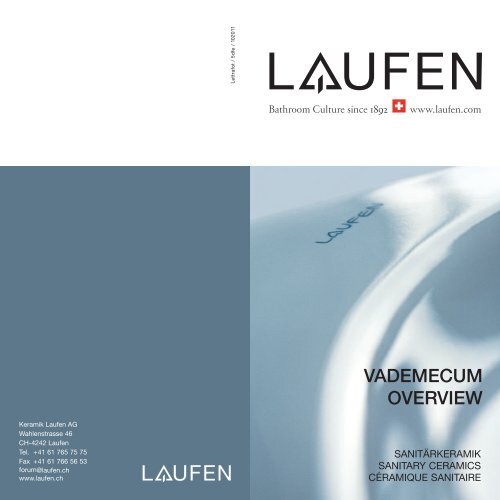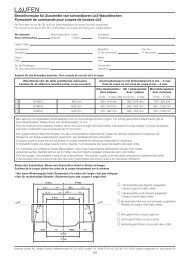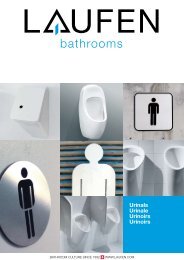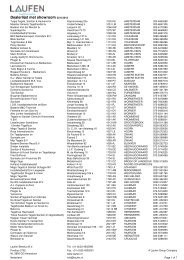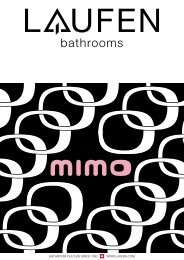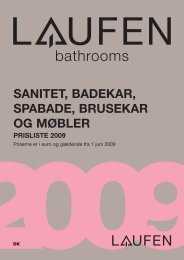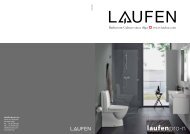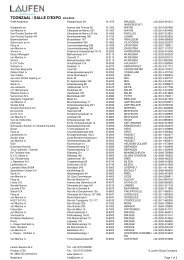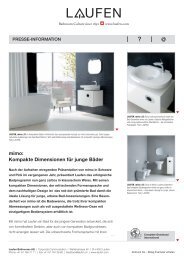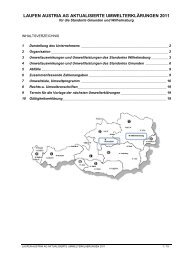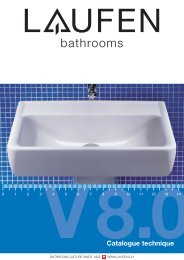Create successful ePaper yourself
Turn your PDF publications into a flip-book with our unique Google optimized e-Paper software.
Lettrafot / 5dfe / 102011<br />
<strong>VADEMECUM</strong><br />
<strong>OVERVIEW</strong><br />
Keramik <strong>Laufen</strong> AG<br />
Wahlenstrasse 46<br />
CH-4242 <strong>Laufen</strong><br />
Tel. +41 61 765 75 75<br />
Fax +41 61 766 56 53<br />
forum@laufen.ch<br />
www.laufen.ch<br />
SANITÄRKERAMIK<br />
SANITARY CERAMICS<br />
CÉRAMIQUE SANITAIRE
DAS UNTERNEHMEN<br />
1892 wurde die Tonwarenfabrik in <strong>Laufen</strong> gegründet. 1926 ist daraus die<br />
heutige Firma Keramik <strong>Laufen</strong> AG geworden. Sie ist heute ein Teil der<br />
weltweiten <strong>Laufen</strong>-Gruppe und gehört zum spanischen Sanitärkonzern<br />
Roca. Die <strong>Laufen</strong>-Gruppe betreibt Produktionsstätten in der Schweiz,<br />
in Österreich und in Tschechien.<br />
THE COMPANY<br />
The <strong>Laufen</strong> Pottery Works were founded in 1892. In 1926, they became<br />
the present-day company of Keramik <strong>Laufen</strong> AG. This is today part of<br />
the world-wide <strong>Laufen</strong> Group and belongs to the Spanish sanitary<br />
company, Roca. The <strong>Laufen</strong> Group operates manufacturing plants in<br />
Switzerland, Austria and the Czech Republic.<br />
LA SOCIÉTÉ<br />
La manufacture de tuiles et briques fondée en 1892 à Laufon est<br />
devenue en 1926 l’actuelle société Keramik <strong>Laufen</strong> AG, qui fait aujourd’hui<br />
partie du groupe d’envergure internationale <strong>Laufen</strong> et appartient au<br />
groupe espagnol Roca. Le groupe <strong>Laufen</strong> exploite des unités<br />
de production en Suisse, en Autriche et en République tchèque.<br />
Living square<br />
3
ILBAGNOALESSI ONE<br />
DATEN ZUR PRODUKTION<br />
In <strong>Laufen</strong> werden pro Jahr an die 380000 Keramikstücke produziert. Die<br />
maximale Kapazität liegt bei etwa 500000 Stück. Über 90% davon sind<br />
Waschtische und WCs. Die meisten davon sind weiss. Nur 2% entfallen<br />
auf farbige Glasuren. Einen bedeutenden Anteil macht heute die optio nale<br />
Glasurvergütung aus, auf der sich Schmutz und Kalk kaum mehr festsetzen<br />
können.<br />
DATA ON PRODUCTION<br />
Some 380000 pieces of ceramic ware are produced in <strong>Laufen</strong> every<br />
year. The maximum capacity is approximately 500000 units. Over 90%<br />
of these are washbasins and toilets. Most are white. Only 2% are colour<br />
glazed. A large proportion of these are today treated with the optional<br />
glaze on which dirt and lime can hardly settle.<br />
LES DONNÉES DE LA PRODUCTION<br />
L’usine produit 380000 appareils de céramique par an. La capacité<br />
de production maximale est de l’ordre de 500000 pièces, à plus de<br />
90% des lavabos et des WC. La plupart sont blancs. Seuls 2% sont<br />
fabriqués dans un émail de couleur. De nombreux produits bénéficient<br />
aujourd’hui du revêtement de surface (en option), grâce auquel les<br />
salissures et le calcaire n’ont pas prise.<br />
4<br />
Palace<br />
5
PRODUKTIONSABLAUF<br />
PRODUCTION PROCESS<br />
DÉROULEMENT DE LA PRODUCTION<br />
Aufbereitung für Masse und Glasur<br />
Preparation for the paste and glaze<br />
Préparation Barbotine et émail<br />
Konventioneller<br />
Guss für anspruchs -<br />
volle Formen<br />
Conventional<br />
casting for<br />
deman ding shapes<br />
Coulage<br />
conventionel pour<br />
les moules délicats<br />
Batteriegiessanlagen<br />
teilautomatisiert<br />
(Waschtische<br />
und WCs)<br />
Battery casting<br />
plants partly auto -<br />
mated (washbasins<br />
and toilets)<br />
Chaînes de coulage<br />
semi-automatisées<br />
(lavabos et WCs)<br />
Druckguss Höchste<br />
Produktionsleistung<br />
Pressure casting<br />
highest production<br />
yield<br />
Coulage sous<br />
préssion haute<br />
productivité<br />
Durchlauftrockner<br />
Continuous-flow dryer<br />
Séchoir tunnel<br />
Handglasieren für Kleinserien<br />
Hand glazing for small runs<br />
Emaillage manuel pour<br />
petites séries<br />
Glasierlinien roboterglasiert<br />
Glazing lines robotized glazing<br />
Chaînes d’émaillages robotisées<br />
Brennofen<br />
Kiln<br />
Fours de cuisson<br />
Sortierung<br />
Sorting<br />
Tri<br />
Endprüfung<br />
Final inspection<br />
Contrôle final<br />
6<br />
<strong>Laufen</strong> pro<br />
Verpackung, Spedition<br />
Packing, despatch<br />
Conditionnement, expédition<br />
7
ROHSTOFFAUFBEREITUNG<br />
Unsere beiden Ausgangsmaterialien sind die plastische Masse und die<br />
Glasur. Diese werden aus verschiedenen Rohstoffen bei uns nach einem<br />
bestimmten Rezept aufbereitet. Für die plastische Masse muss ein<br />
giessfähiger Schlicker, hauptsächlich aus Kaolin und Ton, hergestellt<br />
werden. Die Homogenisierung und Reinigung der Masse dauert fast<br />
24 Stunden. Die Glasur muss andere Eigenschaften aufweisen.<br />
Sie enthält deshalb Kaolin und verschiedene Mineralmehle. Nach<br />
der Aufbereitung wird sie gereinigt und bis zur Verarbeitung gelagert.<br />
PREPARATION OF THE RAW MATERIAL<br />
Our two base materials are plastic paste and glaze. We prepare these<br />
various raw materials according to a certain formula. For the plastic<br />
paste, a pourable slip must be made, mainly of kaolin and clay. The<br />
homogenisation and cleaning of the paste takes nearly 24 hours. The<br />
glaze must have other characteristics. This therefore contains kaolin<br />
and various mineral flours. After preparation, it is cleaned and stored<br />
ready for processing.<br />
PRÉPARATION DE LA MATIÈRE PREMIÈRE<br />
Nos deux matières premières sont la masse plastique et l’émail. Nous<br />
les préparons nous-mêmes à partir de diverses matières premières,<br />
selon une recette bien précise. Pour la masse plastique, il faut fabriquer<br />
une barbotine de coulage, essentiellement à base de kaolin et d’argile.<br />
L’homogénéisation et le nettoyage de la masse dure presque 24 heures.<br />
L’émail doit présenter d’autres propriétés. C’est pourquoi il ne contient<br />
pas d’argile, mais divers minéraux sous forme de farine. Une fois pré paré,<br />
il est stocké en prévision d’une utilisation ultérieure.<br />
8<br />
9
KONVENTIONELLE GIESSEREI<br />
Beim traditionellsten der Giessverfahren wird der Schlicker in saugfähige<br />
Gipsformen gegossen. Sie entziehen dem Schlicker Wasser, so dass<br />
sich innerhalb von etwa 1 Stunde an der Formfläche eine feste Schicht<br />
bildet. Danach kann das Stück aus der Form gelöst, geputzt und nachbearbeitet<br />
werden. Die Formen werden über Nacht getrocknet und sind<br />
am nächsten Tag wieder einsatzbereit. Dieses Giessverfahren eignet sich<br />
für anspruchsvolle Formen und Kleinserien.<br />
LE COULAGE CONVENTIONNEL<br />
Dans le procédé de coulage le plus traditionnel, la barbotine est coulée<br />
dans des moules en plâtre poreux qui absorbent l’eau contenue dans la<br />
barbotine, de sorte qu’en une heure, une pellicule solidifiée se forme sur<br />
les parois du moule. Puis la pièce peut être démoulée, nettoyée et<br />
re-touchée. Les moules sèchent toute la nuit et sont réutilisables dès le<br />
lendemain. Ce procédé de coulage convient aux moules très délicats<br />
et aux petites séries.<br />
CONVENTIONAL CASTING<br />
With the most traditional casting processes, the slip is poured into<br />
absorbent plaster moulds. They extract the water from the slip, so that a<br />
firm layer forms on the surface of the mould within approximately 1 hour.<br />
Then the piece can be removed from the mould, trimmed and reworked.<br />
The mouldings are dried over night and, by the next day, they are ready<br />
for further processing. This casting process is suitable for demanding<br />
forms and small runs.<br />
10 11
BATTERIEGIESSANLAGEN<br />
Technisch wird nach demselben Verfahren gearbeitet, wie in der konventionellen<br />
Giesserei. Es können aber eine ganze Reihe Formen zusammen<br />
ein- und ausgegossen werden. Auch die Entformung ist mechanisch<br />
unterstützt. So erreicht man eine höhere Produktionsleistung und gleichzeitig<br />
wird die körperliche Arbeit erleichtert.<br />
BATTERY-CASTING PLANTS<br />
Technically the same procedure is used as in conventional casting.<br />
However, a whole bank of mouldings can be cast together. Even the<br />
removal from the moulds is mechanically assisted. This both achieves a<br />
higher production yield and at the same time facilitates the manual<br />
labour.<br />
CHAÎNES DE COULAGE<br />
La technique de fabrication est identique à celle du coulage conventionnel.<br />
En revanche, ces installations permettent de couler toute une<br />
série de moules. Le démoulage également est mécanique. On atteint<br />
ainsi un niveau de productivité supérieur et le travail physique est simultanément<br />
grandement allégé.<br />
12<br />
13
DRUCKGUSS<br />
Dieses Giessverfahren ist von <strong>Laufen</strong> für hohe Produktionsleistungen<br />
entwickelt worden. Die Gipsform wird dabei durch eine poröse Kunststoffform<br />
ersetzt. Der Schlicker wird mit hohem Druck eingespritzt und<br />
entwässert sich durch Filtration. Bereits nach 10 Minuten kann das<br />
Stück der Form entnommen werden. Die Form kann ohne Rücktrocknung<br />
sofort wieder eingesetzt werden. Das Verfahren zeichnet sich durch<br />
hohe Oberflächengüte und minimalen Nachbearbeitungsaufwand aus.<br />
PRESSURE CASTING<br />
This casting process was developed by <strong>Laufen</strong> for high-production<br />
yields. Here, the plaster mould is replaced by a porous plastic mould.<br />
The slip is injected under high pressure and drains by filtration. The<br />
casting can be removed from the mould after only 10 minutes. The<br />
mould can be immediately reused without any pre-drying process.<br />
The procedure is characterised by high surface quality and minimum<br />
reworking costs.<br />
LE COULAGE SOUS PRESSION<br />
Ce procédé de coulage a été développé par <strong>Laufen</strong> pour atteindre des<br />
niveaux de productivité supérieurs. Le moule en plâtre est remplacé<br />
par un moule en résine poreuse. La barbotine est injectée sous haute<br />
pression, et l’eau qu’elle contient est évacuée presque immédiatement<br />
par filtration. 10 minutes plus tard, on peut déjà retirer la pièce du moule.<br />
Le moule est réutilisable instantanément sans séchage. Le procédé<br />
présente deux atouts: le haut niveau de qualité de surface du moule et<br />
le minimum de travail de retouche requis.<br />
14<br />
15
TROCKNER<br />
Die entformten Rohlinge sind zwar formstabil, aber noch weich und<br />
empfindlich. Damit sie glasiert und gebrannt werden können, müssen<br />
sie bis auf eine Restfeuchte von weniger als 1% getrocknet werden.<br />
Dazu werden sie von Förderanlagen zum Trockner transportiert und<br />
durchlaufen diesen innerhalb von einigen Stunden. Nachher hat sich<br />
der Scherben soweit verfestigt, dass er problemlos weiterverarbeitet<br />
werden kann.<br />
DRIER<br />
The castings, although rigid on removal from the moulds are nevertheless<br />
still soft and fragile. In order that they may be glazed and fired, they<br />
must be dried up to a residual moisture of less than 1%. For this<br />
purpose, they are transported to the dryer on conveyer belts over<br />
several hours. After this, the bodies have solidified so that they can be<br />
further processed without any problem.<br />
LE SÉCHOIR TUNNEL<br />
Les galettes démoulées sont indéformables mais encore souples et<br />
fragiles. Pour qu’elles puissent être émaillées et cuites, elles doivent<br />
être séchées jusqu’à obtention d’un taux d’humidité résiduelle inférieur<br />
à 1%. Elles sont donc transportées vers le séchoir par l’intermédiaire<br />
de convoyeurs, et séchées en quelques heures. Le procédé confère à<br />
la pièce brute une solidité telle qu’elle peut être soumise sans problème<br />
aux traitements suivants.<br />
16 17
HANDGLASIEREN<br />
Kleinserien, seltene Farben und sehr komplizierte Formen werden von<br />
Hand glasiert. Der Auftrag – ob von Menschenhand oder vom Roboter –<br />
hat eine Dicke von weniger als einem Millimeter. Die Glasur sieht jetzt<br />
noch matt und blau- oder rosafarben aus. Erst beim Brennen wird sie<br />
glasig und erhält so ihre charakteristische Härte und ihren edlen Glanz.<br />
HAND GLAZING<br />
Small runs, rare colours and very complicated shapes are glazed by<br />
hand. The coating – whether applied by human hand or by robot – is<br />
less than one millimetre thick. The glaze now still looks matt and blue or<br />
pink in colour. Only after firing will it become glossy and so assume its<br />
characteristic hardness and noble gloss.<br />
L’ÉMAILLAGE MANUEL<br />
Les petites séries, les couleurs rares et les formes très complexes<br />
sont émaillées manuellement. L’épaisseur de la couche d’émail – qu’il<br />
s’agisse d’une application manuelle ou robotisée – est inférieure à un<br />
millimètre. Mais à ce stade, l’émail est encore mat et bleue ou rosâtre.<br />
C’est à la cuisson qu’il se vitrifiera et obtiendra sa dureté caractéristique<br />
et son brillant parfait.<br />
18<br />
19
GLASIERLINIEN<br />
Die drei Roboter-Glasierlinien arbeiten vollautomatisch. Ein optisches<br />
Erkennungssystem identifiziert das Stück. Der Roboter sprüht die<br />
Glasurschicht entsprechend auf und reinigt daraufhin den Arbeitsplatz<br />
für das nächste Stück. Der glasierte Rohling wird von Mitarbeitern<br />
kontrolliert, auf eine hitzebeständige Plattform gesetzt und automatisch<br />
zum Brennofen transportiert.<br />
GLAZING LINES<br />
The three robotic glazing lines work fully automatically. An optical<br />
recognition system identifies the piece. The robot sprays the glaze<br />
layer accordingly and then cleans the workplace for the next piece.<br />
The glazed blanks are checked by operators, placed on a heatresistant<br />
platform and automatically transported to the kiln.<br />
LES CHAÎNES D’ÉMAILLAGE<br />
Les trois chaînes d’émaillage robotisées sont entièrement automatiques.<br />
Un dispositif de détection optique identifie la pièce. Le robot pulvérise<br />
la couche d’émail en fonction de la pièce et nettoie le poste de travail<br />
avant de recevoir la pièce suivante. La galette émaillée est contrôlée par<br />
le personnel, placée sur une plate-forme réfractaire, puis transportée<br />
automatiquement vers le four de cuisson.<br />
20<br />
21
BRENNÖFEN<br />
Der Tunnelofen hat eine Länge von über 100 Metern und erreicht eine<br />
Maximaltemperatur von 1250 Grad Celsius. Er wird mit umweltfreundlichem<br />
Erdgas betrieben, das schadstofffrei verbrennt. Das Brenngut<br />
durchfährt den Ofen auf den feuerfesten Herdwagen in einer Zeit von<br />
22 bis 26 Stunden. Die Durchfahrt folgt einer bestimmten Brennkurve<br />
(Vorwärmen, Brennen, Abkühlen). Dabei laufen chemisch-physikalische<br />
Prozesse ab, die der Keramik ihre einzigartigen Eigenschaften verleihen.<br />
Übrigens: Beim Brennen schwindet der Scherben um etwa 10%. Das<br />
muss in der Originalgiessform berücksichtigt werden.<br />
FOURS DE CUISSON<br />
Le four tunnel mesure plus de 100 mètres de long et atteint une température<br />
maximale de 1250 degrés Celsius. Il fonctionne au gaz naturel<br />
écologique, qui brûle pratiquement sans émissions polluantes. La pièce<br />
à cuire traverse le four sur le wagonnet réfractaire pendant 22 à 26 heures.<br />
Le passage dans le four suit un cycle précis (préchauffage, cuisson,<br />
refroidissement). Les processus physico-chimiques qui se déroulent lors<br />
de la cuisson confèrent à la céramique ses propriétés uniques.<br />
A noter: lors de la cuisson, la pièce brute se rétracte d’environ 10%.<br />
Il conviendra d’en tenir compte pour le moule de coulage d’origine.<br />
THE KILNS<br />
The tunnel kiln is over 100 metres long and attains a maximum temperature<br />
of 1250 degrees Celsius. It is operated with non-polluting natural<br />
gas, which leaves no environmentally-harmful residue. The casting<br />
traverses the kiln on the fireproof dollies in a time of 22 to 26 hours.<br />
The passage follows a specific heating curve (preheat, firing, cooling).<br />
As this proceeds, chemical and physical processes take place which<br />
give the ceramic its singular characteristics. Moreover, during the kilning<br />
process, the casting shrinks by approximately 10%. That must be taken<br />
into account in the original mould.<br />
22 23
SORTIERUNG<br />
Nach dem Brand wird jedes Stück genauestens auf seine Qualität<br />
geprüft. Fehlerlose Apparate mit einwandfreier Form und Glasur werden<br />
zur Funktionsprüfung und Endbearbeitung weitergeleitet. Beanstandete<br />
Apparate gelangen je nach Mangel direkt ins Recycling oder in die<br />
Reparatur. Dort können kleine Glasurfehler ausgeschliffen und neu glasiert<br />
werden. Der Nachbrand in einem speziellen Ofen garantiert, dass<br />
die reparierte Stelle ohne Qualitätsverlust verschmilzt.<br />
SORTING<br />
After firing, each piece is scrupulously examined for quality. Faultless<br />
units of perfect form and glaze are passed on for functional testing and<br />
finishing. Defective units will, depending upon their defects, be returned<br />
directly to recycling or go to the repair workshop. There, minor glazing<br />
defects can be buffed and reglazed. They are then post-fired in a special<br />
kiln to guarantee that the repaired place merges with the surrounding<br />
area with no loss of quality.<br />
LE TRI<br />
Au terme de la cuisson, la qualité de chaque pièce cuite est rigoureusement<br />
contrôlée. Seuls les appareils sans défaut, présentant une forme<br />
et un émail parfaits, subissent un contrôle technique de fonctionnement<br />
puis sont dirigés vers les étapes finales. Selon le type de défaut, les<br />
appareils refusés sont orientés directement vers le recyclage ou vers<br />
l’atelier de réparation, où les petits défauts d’émail pourront être rectifiés<br />
et ré-émaillés. Les appareils sont à nouveau cuits dans un four spécial<br />
qui garantit que partie réparée fusionne sans perte de qualité.<br />
2424<br />
25
ENDPRÜFUNG<br />
Apparate, welche die erste Qualitätskontrolle passiert haben, werden<br />
der technischen Prüfung unterzogen. Alle WCs und Urinale werden mit<br />
Vakuum auf ihre Dichtigkeit geprüft. Montageflächen werden kontrolliert<br />
und wenn nötig plan geschliffen. Jetzt sind die Apparate freigegeben,<br />
werden elektronisch erfasst, verpackt und ins Warenlager überführt.<br />
FINAL INSPECTION<br />
Units which have passed the first quality check are now submitted to<br />
a technical examination. All WCs and urinals are vacuum-tested for<br />
tightness. Assembly surfaces are checked and, if necessary, buffed flat.<br />
The units are now approved, electronically registered, packed and<br />
transferred to the warehouse.<br />
LE CONTRÔLE FINAL<br />
Les appareils qui ont passé le premier contrôle de qualité, sont ensuite<br />
soumis au contrôle technique. Tous les WC et les urinoirs subissent un<br />
test d’étanchéité sous vide. Le plan de montage est contrôlé et rectifié<br />
si nécessaire. Puis les appareils reçoivent l’autorisation, sont saisis<br />
électroniquement, conditionnés et transférés dans l’entrepôt.<br />
26<br />
27
LAGER UND SPEDITION<br />
Im Fertiglager stehen durchschnittlich 80000 Artikel in Form von<br />
Sanitärapparaten, Bade- und Duschwannen, Badezimmermöbel und<br />
Accessoires bereit. Durch die Bewirtschaftung wird ein Lieferfähig -<br />
keitsgrad von über 95% erreicht, damit können die Kunden direkt<br />
ab Lager und ohne lange Lieferfristen bedient werden.<br />
STORAGE AND DESPATCH<br />
On average 80000 articles are available in the finished-product store<br />
in the form of sanitary appliances, bathtubs and shower trays, bathroom<br />
furniture and accessories. By proper management, we can deliver over<br />
95% of orders directly from stock, thus sparing customers long delivery<br />
times.<br />
ENTREPÔT ET EXPÉDITION<br />
Notre entrepôt stocke en moyenne 80000 articles, sous forme d’appa reils<br />
sanitaires, baignoires et receveurs de douche, meubles de salle de bain<br />
et accessoires. Cette gestion de stockage nous permet d’atteindre une<br />
capacité de livraison supérieure à 95%, nos clients pouvant ainsi rece -<br />
voir leur marchandise directement départ entrepôt et sans subir de longs<br />
délais de livraison.<br />
28<br />
29
Palomba Collection<br />
Lb3<br />
ILBAGNOALESSI DOT


